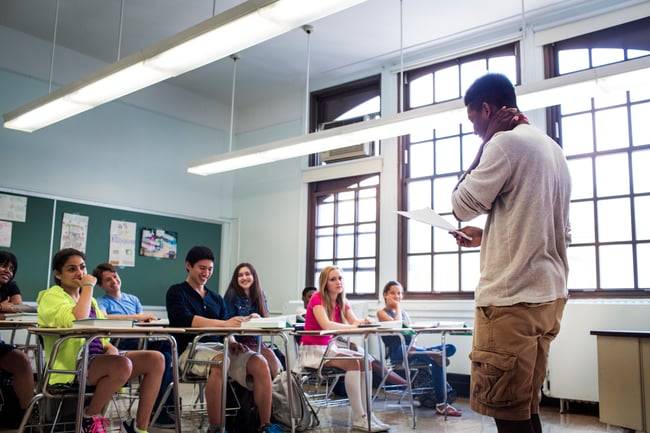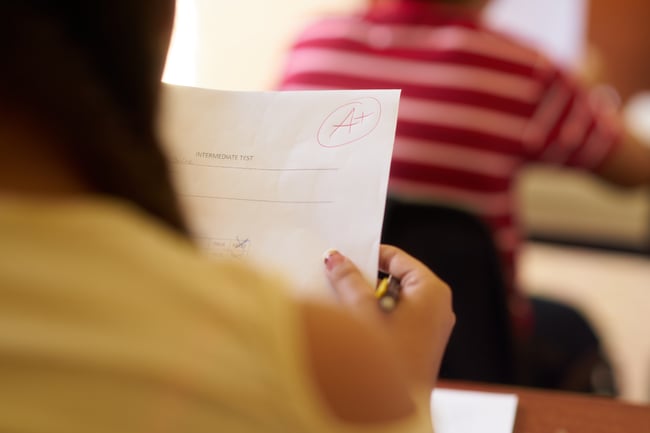4 Reasons to Use PBIS for Middle School Behavior Management
Four reasons why PBIS behavior management for middle school students is highly effective at improving behavior, suspensions, and more.
Most educators understand and appreciate that students in middle school are a unique group of students, and their educational, behavioral, social, and emotional needs must be addressed in special ways.
This is because middle school students must go through the experience of all the transformations associated with puberty: rapid biological changes, social changes, and changes in their educational environment.
The Transition from Elementary to Middle School
As students transition from elementary school to middle school, they experience massive changes in their educational experience and social networks:
- While elementary school often provides one teacher for a student, middle school involves a greater number of teachers who typically can’t provide the same level of support as an elementary school teacher.
- Middle school introduces an increased emphasis on discipline with a concomitant decline in student autonomy, which can increase student rebellion.
- From an academic standpoint, middle school introduces an increase in academic competitiveness and grade point averages.
- As students move into middle school, there’s frequently a breakup of their established peer network. These students must create a new network while experiencing less social support and increased daily stress in school.
- Middle schoolers often engage in riskier behaviors as they attempt to exert autonomy over their world.
What Research Tells Us
Given these factors, it’s not surprising that some studies show that two-thirds of students in middle school are disengaged. By contrast, only about one-third of children in elementary school are disengaged.
As middle school students navigate this developmental phase, several areas often experience declines:
- Grades
- Interest in school
- Beliefs in academic and social competence
- Self-esteem
Meanwhile, general psychological distress often increases.
Puberty and the middle school years increase opportunities for both positive and negative outcomes, making this an especially important time for educators to provide special strategies.
The Importance of a Positive School Climate
Research has repeatedly shown the positive effects of a healthy school climate on students outcomes, particularly at the middle school level:
- School climate has been shown to improve grade point averages, standardized test scores, reading proficiency, academic writing, and general adjustment to school (Brand, Felner, Seitsinger, Burns and Bolton, 2008; Espisito, 1999; Garrison, 2004; Pritchard, et. al., 2005).
- School climate has been shown to reduce occurrences of student behavioral issues (i.e., aggression, violence, antisocial behavior, absenteeism) (Aveyard et al., 2004; Brand et al., 2008; Gottfreson et al., 2005).
- A positive school climate can also improve more internalizing factors, such as student aspirations, optimism, self-esteem, and general well-being (Brand et al., 2008; Ruus et al., 2007).
School climate has many definitions and frameworks, but most agree that it is a comprehensive phenomenon which includes the physical and psychosocial (Caldarella et al., 2011).
The impact of a healthy school climate is especially important in secondary school settings, where behavioral issues are significantly more serious than in elementary schools such as bullying (Caldarella et al., 2011).
The empirical evidence also indicates that middle schoolers are at increased risk for developing mental health disorders such as depression, anxiety, and other internalizing disorders (Alloy & Abramson, 2007).
Studies show that schools with positive climates are more proactive and preventative with regards to student behavior and social-emotional status, while schools with poor climates are reactive and highly punitive without a focus on reinforcing positive behaviors and relationships.

PBIS for Middle School Students and Classroom Management
One of the most powerful mechanisms for creating a positive school climate in middle schools is through the implementation of positive behavior support systems.
Often known as positive behavior interventions and supports (PBIS), positive behavior supports focuses on teaching appropriate behaviors — reinforcing and expanding the behavioral and emotional regulation skills to multiple environments — in contrast to schools that approach student behavior from a reactive and punitive perspective.
Positive behavior supports help schools reduce inconsistent negative and punitive responses to student behavioral issues by helping staff increase the frequency of positive reinforcement of appropriate behavior and general positive interactions.
Climate will also be improved through a consistent and expected application of discipline and reinforcement. Students will have a sense of positive climate as they view their teachers as fair and equitable in their responses.
PBIS has great value for helping students cope with the daily stressors of middle school.
Below are four reasons you should implement PBIS in your own middle school.
Reason #1: PBIS Improves Middle School Behavior
There is a growing body of research that supports improvements in disciplinary behavior, anti-social behavior, student bullying behavior, and peer victimization related to implementing positive behavior support systems (Bradshaw, Koth, Thornton, & Leaf, 2009; Bradshaw, Mitchell, & Leaf, 2010; Horner, Sugai, & Anderson, 2010; Sadler & Sugai, 2009; Simonsen et al., 2012; Waasdorp, Bradshaw, & Leaf, 2012).
Multilevel, longitudinal analyses indicated that, relative to the children in comparison schools, those in PBIS schools displayed:
- Lower levels of disruptive behavior problems and concentration problems
- Better emotion regulation
- More prosocial behavior
There were also significant intervention effects on children’s odds of receiving an office discipline referral (Bradshaw, C. Waasdorp, T., Leaf, P., 2012).
SchoolMint Hero provides a platform for the systematic implementation of the core practices of PBSS and PBIS:
- Behavioral expectations
- Reinforcement for meeting expectations
- Consistency of teacher responses to student behavior
- Frequent student feedback
- Corrective responses
Reason #2: PBIS Reduces Absenteeism in Middle School
Absenteeism is a problem that often manifests more significantly once students reach middle school.
Positive behavior supports embrace several approaches and frameworks that are research-based and have proven to reduce certain academic barriers, such as chronic absenteeism (Sugai & Simonsen, 2012).
Nelson, J. (2019) concluded that PBIS programs are beneficial and effective in reducing chronic attendance patterns if the PBIS faculty works in a school culture that provides comprehensive professional development and a creative student incentive program.
The institution of consistent responses to behavior, positively reinforcing good behavior, providing corrective responses, and tracking students in behavioral interventions can result in improved attendance.
Reason #3: PBIS Reduces Suspensions and Exclusions in Middle School
Multiple studies have shown that PBIS significantly reduces both antisocial behavior of students and the use of suspension by school personnel (Bradshaw, Mitchell, & Leaf, 2010; Bradshaw, Waasdorp, & Leaf, 2012; Nelson, Martella, & Marchand-Martella, 2002).
Due to this overall effectiveness, the framework has been viewed as a potentially effective approach for not only reducing overall suspensions of special education students but also for reducing racial disparities in suspensions (Gregory, Skiba, & Mediratta, 2017; Tobin & Vincent, 2011).
Reason #4: PBIS Improves Middle School Academic Performance
Research studies have supported that the use of positive behavior approaches can improve the academic performance of students.
A comprehensive review of studies dating back to the year 2000 suggests that a positive climate (which is supported by PBIS, as described earlier) can result in student academic outcomes that are significantly higher at high- and medium-fidelity PBIS schools than low-fidelity PBIS schools (Houchens, G., Zhang, J., Davis, K., 2017).
Benefits of PBIS in Middle Schools
Although the data is quite compelling about the efficacy of positive behavior supports, most studies have focused on elementary schools. Relative to middle schools, there is a much less robust research base.
- Warren et al., 2006 reported impressive results when implementing PBIS in an urban middle school: a 20% reduction in referrals and a 57% reduction in suspensions.
- A study in five middle schools by Muscott et al., (2008) reported a 36% reduction in referrals, a 37% reduction in in-school suspension, and a 35% reduction in out-of-school suspension.
- Numerous studies in secondary schools find that PBIS reduces the amount of time spent dealing with discipline and improves student-teacher relationships (Warren, et al., 2006; Lassen et al., 2006).
- An important quasi-experimental study (Calderella et al., 2011) in two middle schools found PBIS resulted in significantly improved school climate and significant reductions in student behavioral issues, tardiness, unexcused absences, and office discipline referrals compared to the control school.
New Hampshire implemented school-wide PBIS across the state in 2002. Results indicated that the overwhelming majority of schools implemented school-wide positive behavioral interventions and supports with fidelity within two years.
- The data indicated a reduction of 6,010 office discipline referrals and 1,032 suspensions. Middle and high schools experienced the most benefits across the state.
- These reductions helped recover 864 days of teaching, 1,701 days of learning, and 571 days of leadership.
Implementation was associated with academic gains in math for the vast majority of schools that implemented PBIS with fidelity. However, improvements in reading/language arts were less pervasive (Muscott, H., Mann, E., LeBrun, M., 2008).
Nocera, Whitbread & Nocera (2014) completed a study in a single middle school with a focus on evidence-based academic interventions and school-wide positive behavior supports. The results indicated a 36% reduction in office discipline referrals and a 39% reduction in suspensions over the three years of the study.
Additionally, students rated factors regarding climate and culture of the school much more favorably post-intervention.
There were also academic gains: a review of state mastery test data showed a 25% increase in reading scores and an 11% increase in math scores from 2007 to 2010.

Despite these important findings in middle schools, however, PBIS approaches had not been evaluated in a randomized controlled trial in middle schools until Sprague et al., (2017) completed a randomized controlled study with 35 middle schools in the northwest.
The results of this important study indicated that students in the treatment schools reported significantly less growth in antisocial behavior and substance abuse and an increase in rule compliance across grade levels compared to control schools.
Students in the PBIS schools have a greater sense of safety in all grade levels. Not all dependent measures were significant, which led the authors to state that there is a need to refine and add intervention elements to the basic PBIS protocol to further strengthen observed effects with a focus on classroom management for teachers.
Improve Middle School Student Behavior with SchoolMint Hero
One of the best ways to strengthen the protocols and improve classroom management as suggested by Sprague et al. (2017) would be to implement a software platform that is aligned to the best practices of positive behavior support systems (PBSS) and PBIS. This can provide consistency and fidelity of implementation — as well as lead to improved student outcomes.
SchoolMint Hero is a PBIS-focused software system designed to deliver PBIS practices. Hero helps schools with consistent responses to behavior — positively reinforcing good behavior, providing corrective responses, and tracking students in behavioral interventions.
Hero also provides a systematic method for achieving the five-to-one positive interaction ratio that is critical to improve student-teacher relationships, school climate, and academic engagement.
One study of the impact of Hero in a large Florida high school reported a 65% reduction in chronic absenteeism, a 38% reduction in behavior referrals, a 52% reduction in suspensions, and a significant increase in school GPA after one year of high-fidelity implementation.
Share this
You May Also Like
These Related Stories

Transforming School Culture: How Consistent Behavior Management Drives Success

Data-Driven Decision Making: Leveraging Behavior Analytics to Improve School Outcomes



